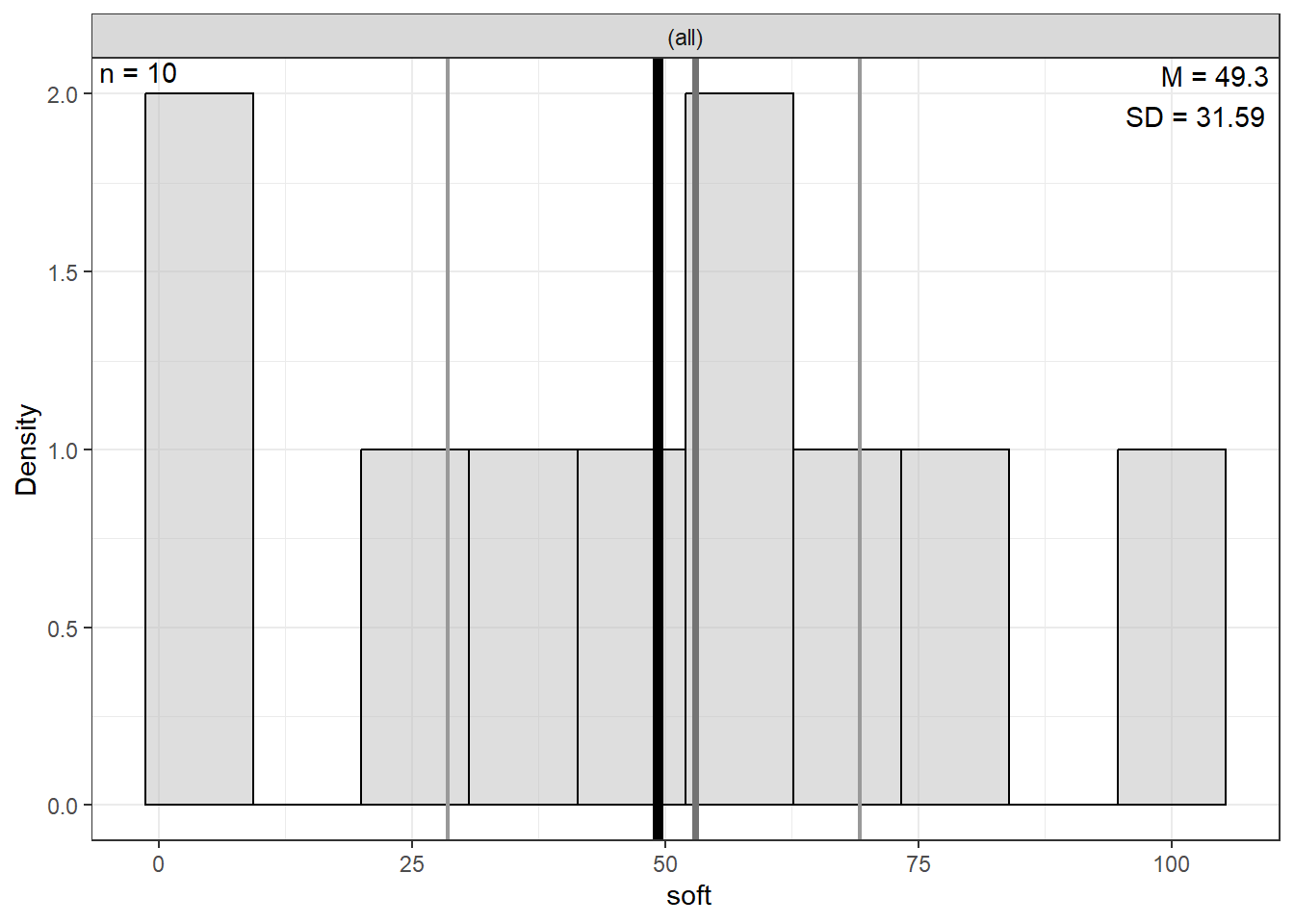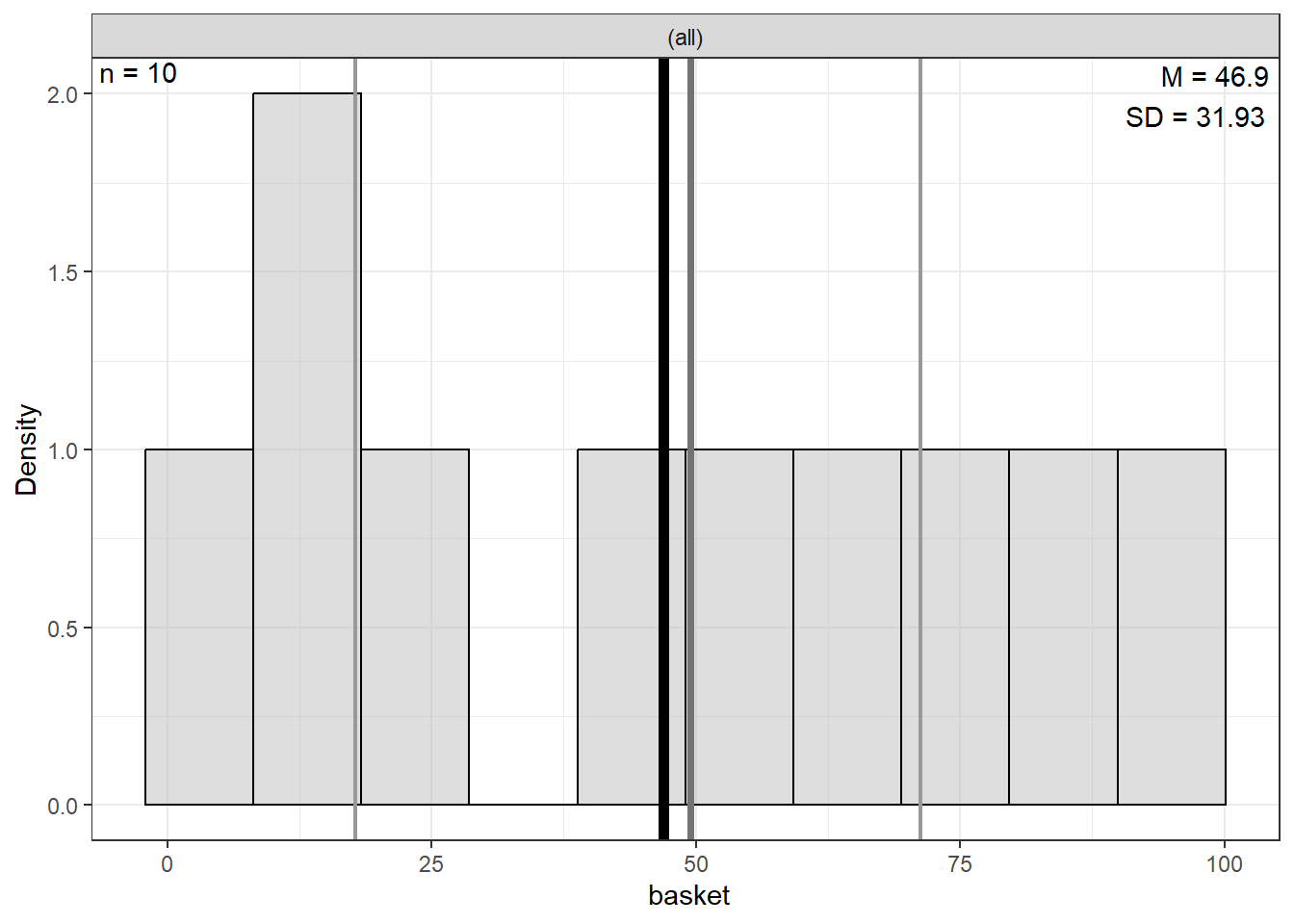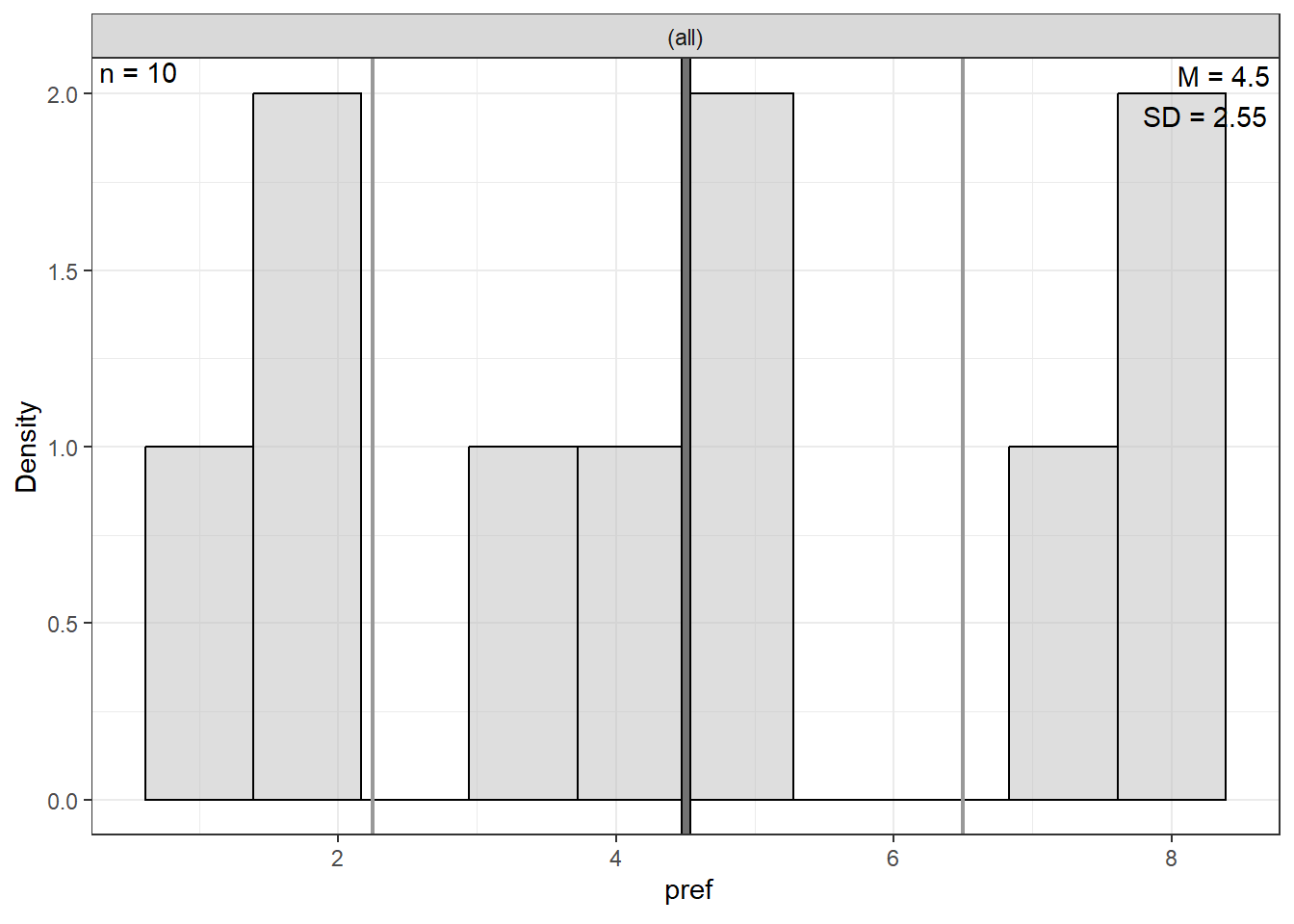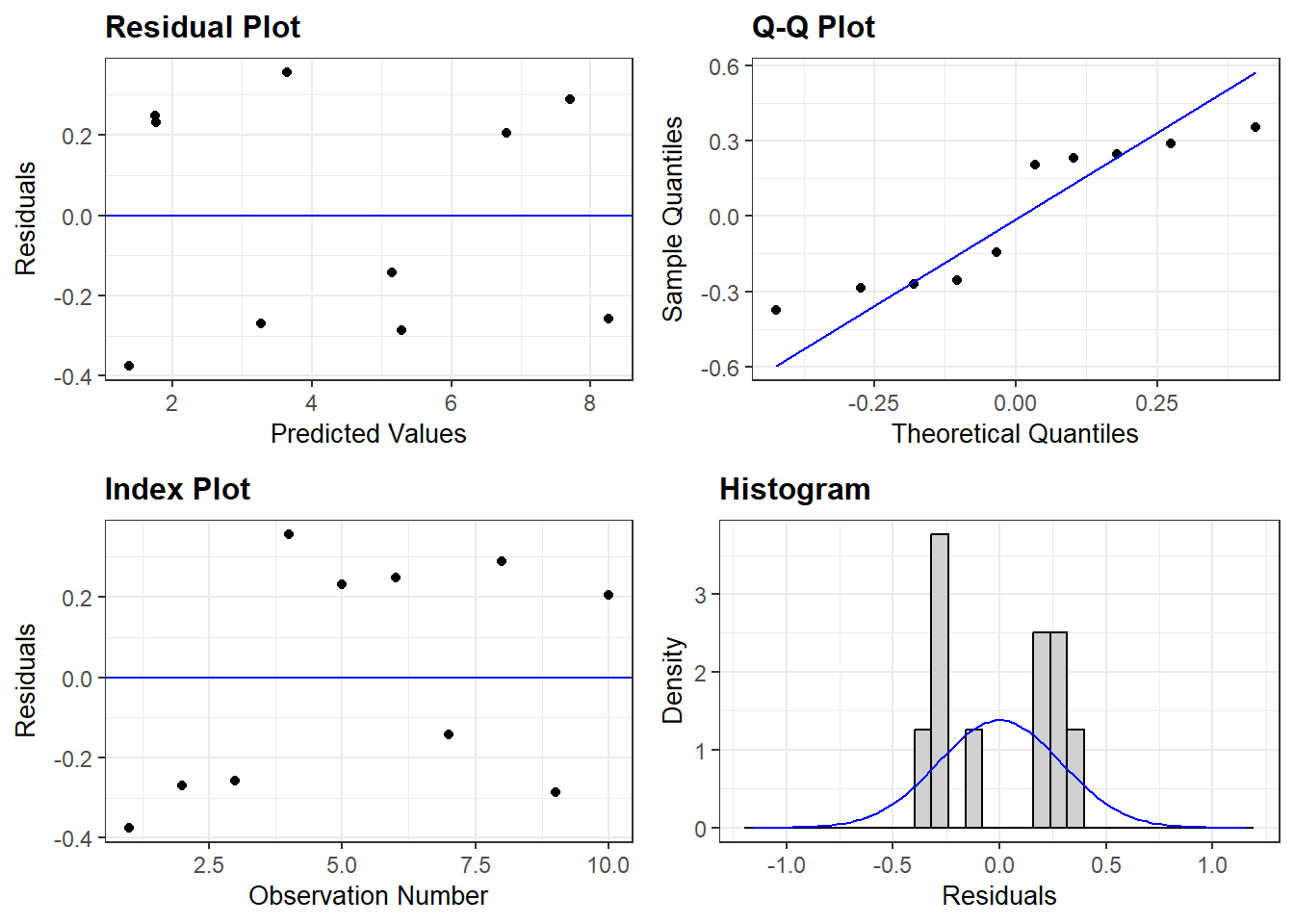4 D&H Ch3b - Multiple Regression: “Sport Skill”
Compiled: October 15, 2025
Darlington & Hayes, Chapter 3’s second example
# install.packages("remotes")
# remotes::install_github("sarbearschwartz/apaSupp") # 9/17/2025
library(tidyverse)
library(flextable)
library(apaSupp) # not on CRAN, get from GitHub (above)
library(GGally)
library(ggpubr)
library(interactions)
library(effectsize)
library(performance)
library(ggResidpanel)4.1 PURPOSE
4.1.2 Data Description
4.1.2.1 Variables
Independent Variables (IV, \(X\))
* soft skill at softball
* basket skill at basketball
Dependent Variable (DV, \(Y\))
* pref On a scale from 1 to 9, which sport do you prefer?”
+ 1 = much prefer softball
+ 5 = no preference
+ 9 = much prefer basketball
df_sport <- tibble::tribble(~id, ~soft, ~basket, ~pref,
1, 4, 17, 1,
2, 56, 60, 3,
3, 25, 3, 8,
4, 50, 52, 4,
5, 5, 16, 2,
6, 72, 84, 2,
7, 100, 95, 5,
8, 39, 20, 8,
9, 81, 75, 5,
10, 61, 47, 7)df_sport %>%
dplyr::select("ID" = id,
"Softball Skill" = soft,
"Basketball Skill" = basket,
"Preference Score" = pref) %>%
flextable::flextable() %>%
apaSupp::theme_apa(caption = "D&H TAble 3.5 (pg 78) Skill at Softball, Basketball, and Preference") %>%
flextable::colformat_double(digits = 0)ID | Softball Skill | Basketball Skill | Preference Score |
|---|---|---|---|
1 | 4 | 17 | 1 |
2 | 56 | 60 | 3 |
3 | 25 | 3 | 8 |
4 | 50 | 52 | 4 |
5 | 5 | 16 | 2 |
6 | 72 | 84 | 2 |
7 | 100 | 95 | 5 |
8 | 39 | 20 | 8 |
9 | 81 | 75 | 5 |
10 | 61 | 47 | 7 |
4.2 EXPLORATORY DATA ANALYSIS
4.2.1 Univariate Statistics
Center: mean and median Spread: standard deviation, range (max - min), interquartile range (Q3 - Q1)
df_sport %>%
dplyr::select("Softball Skill" = soft,
"Basketball Skill" = basket,
"Preference Score" = pref) %>%
apaSupp::tab_desc(caption = "Summary Statistics")NA | M | SD | min | Q1 | Mdn | Q3 | max | |
|---|---|---|---|---|---|---|---|---|
Softball Skill | 0 | 49.30 | 31.59 | 4.00 | 28.50 | 53.00 | 69.25 | 100.00 |
Basketball Skill | 0 | 46.90 | 31.93 | 3.00 | 17.75 | 49.50 | 71.25 | 95.00 |
Preference Score | 0 | 4.50 | 2.55 | 1.00 | 2.25 | 4.50 | 6.50 | 8.00 |
Note. N = 10. NA = not available or missing; Mdn = median; Q1 = 25th percentile; Q3 = 75th percentile. | ||||||||
4.2.3 Bivariate Statistics
df_sport %>%
dplyr::select("Softball Skill" = soft,
"Basketball Skill" = basket,
"Preference Score" = pref) %>%
apaSupp::tab_cor(caption = "Unadjusted, Pairwise Correlations")Variable Pair | r | p | |
|---|---|---|---|
Softball Skill | Basketball Skill | .920 | < .001*** |
Softball Skill | Preference Score | .210 | .562 |
Basketball Skill | Preference Score | -.190 | .590 |
Note. N = 10. r = Pearson's Product-Moment correlation coefficient. | |||
* p < .05. ** p < .01. *** p < .001. | |||
4.2.4 Bivariate Visualization
df_sport %>%
dplyr::select("Softball Skill" = soft,
"Basketball Skill" = basket,
"Preference Score" = pref) %>%
data.frame %>%
GGally::ggscatmat() +
theme_bw()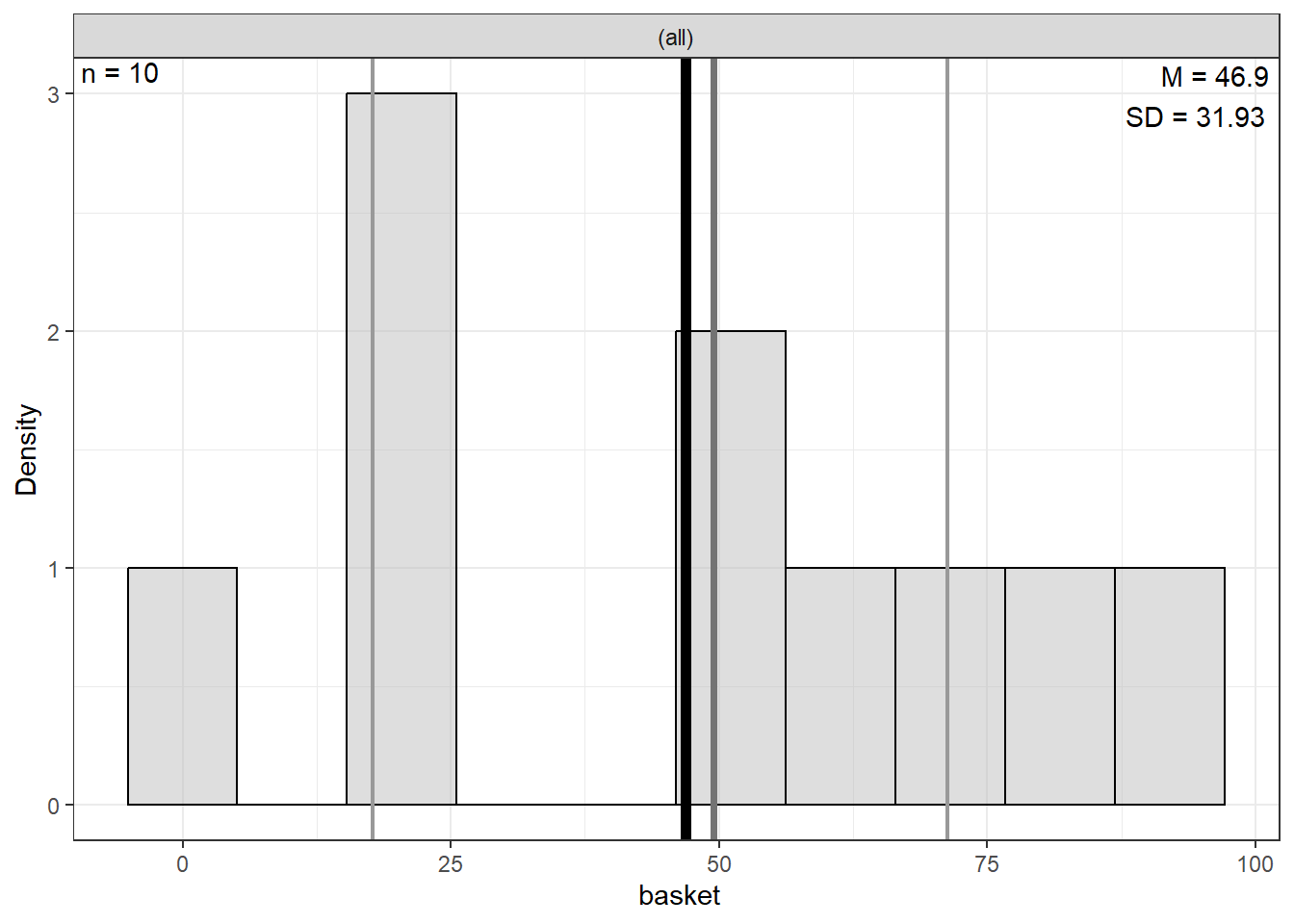
df_sport %>%
ggplot(aes(x = soft,
y = pref)) +
geom_point() +
geom_smooth(method = "lm",
formula = y ~ x) +
ggpubr::stat_regline_equation(label.x = 75,
label.y = 1,
size = 6) +
theme_bw() +
labs(x = "Softball Skill",
y = "Preference")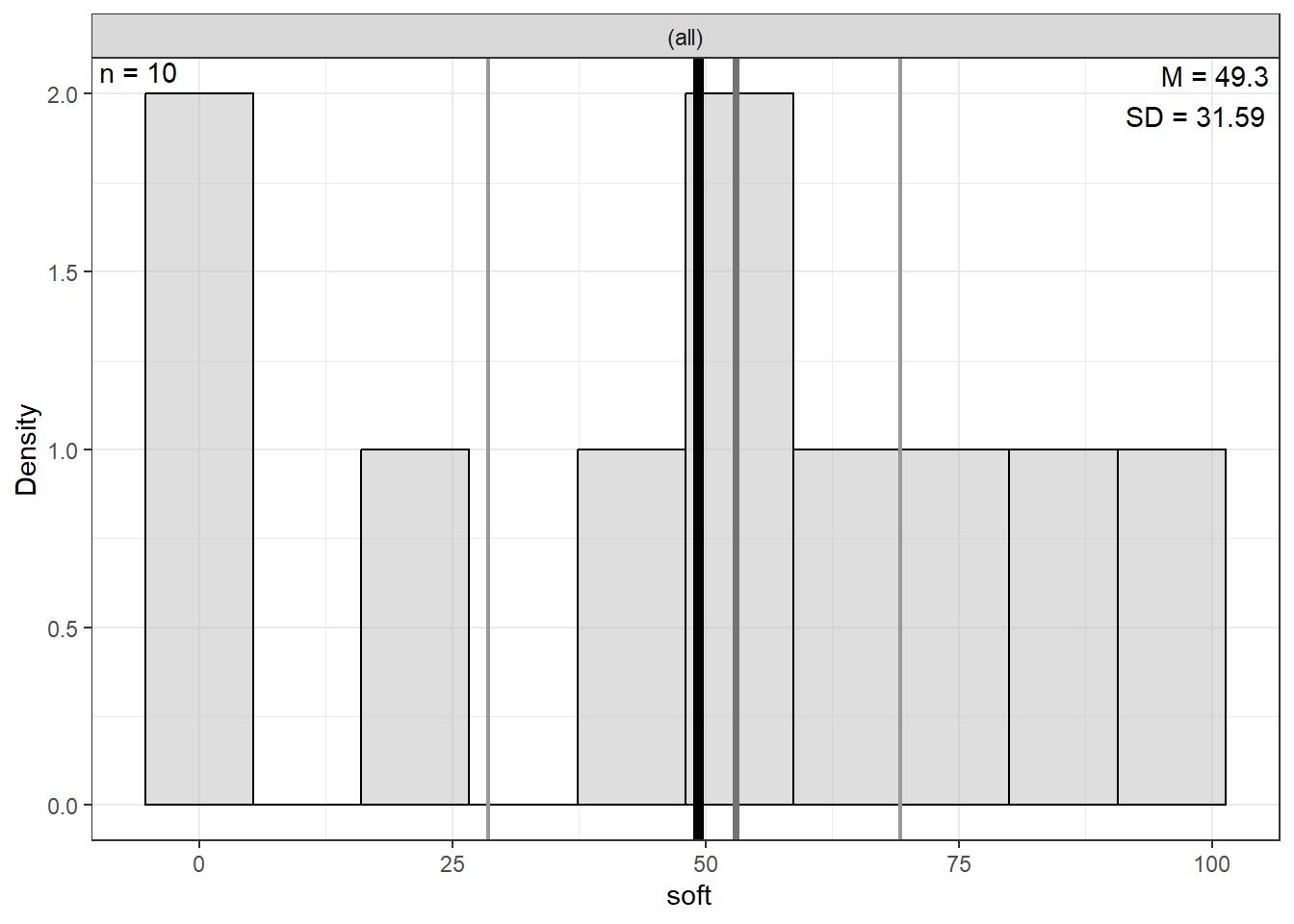
df_sport %>%
ggplot(aes(x = basket,
y = pref)) +
geom_point() +
geom_smooth(method = "lm",
formula = y ~ x) +
ggpubr::stat_regline_equation(label.x = 75,
label.y = 1,
size = 6) +
theme_bw() +
labs(x = "Basketball Skill",
y = "Preference")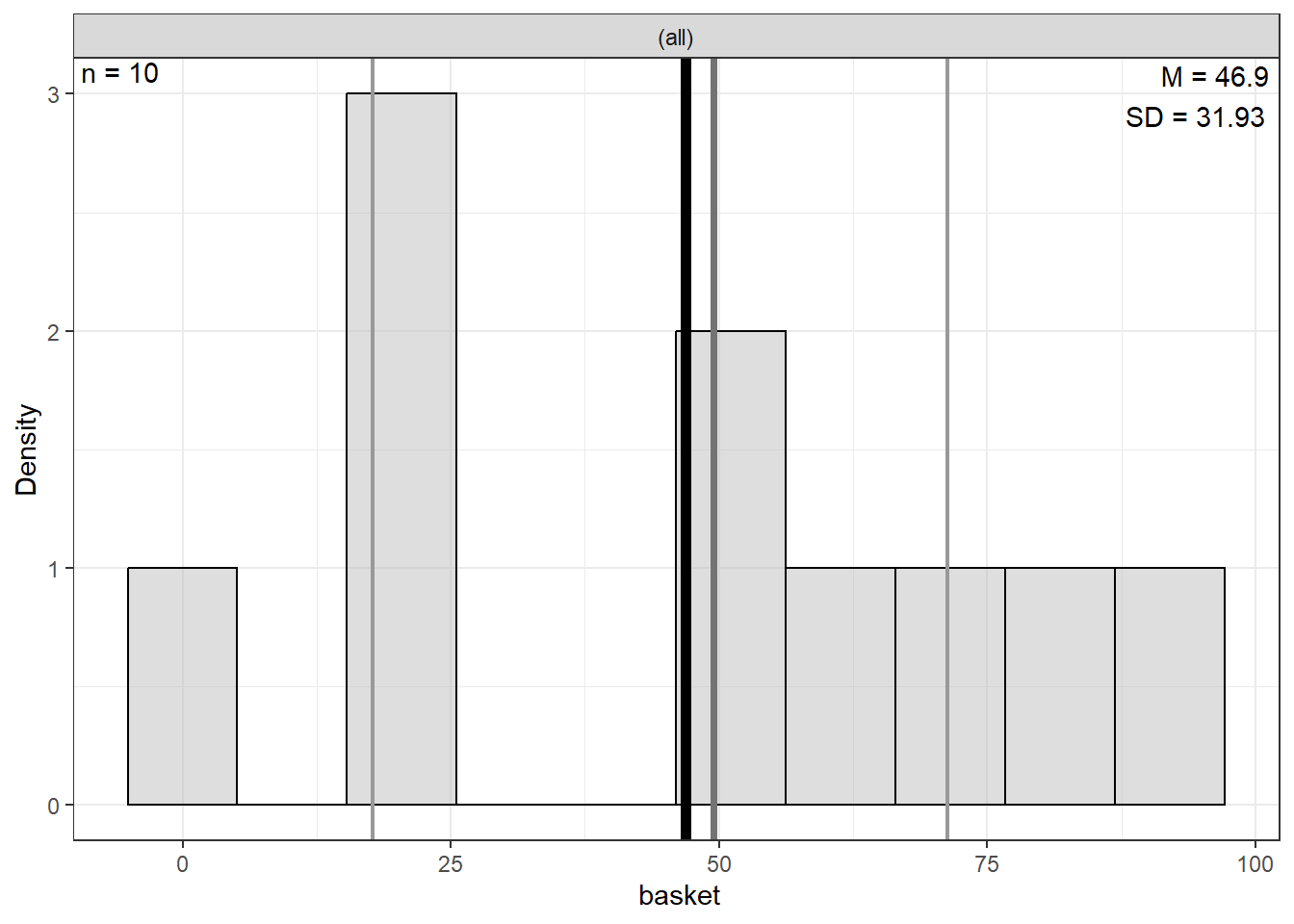
4.3 REGRESSION ANALYSIS
- The dependent variable (DV) is preference (\(Y\))
- The independent variable (IVs) are skill levels (\(X\))
4.3.1 Fit the Models
fit_lm_soft <- lm(pref ~ soft,
data = df_sport)
fit_lm_basket <- lm(pref ~ basket,
data = df_sport)
fit_lm_both <- lm(pref ~ soft + basket,
data = df_sport)tab_lm3 <- apaSupp::tab_lms(list("Softball" = fit_lm_soft,
"Basketball" = fit_lm_basket,
"Both" = fit_lm_both),
var_labels = c("soft" = "Softball Skill",
"basket" = "Basketball Skill"),
caption = "Parameter Estimates for Sport Preference Regression on Skill Level in Softball and Basketball",
general_note = "Dependent variable is preference rating on a scale of 1 (much prefer softball) to 9 (much prefer basketball). Both softball and Baksetball skill levels are on a scale of 0 to 100.",
narrow = TRUE,
d = 3)
tab_lm3
| Softball | Basketball | Both | |||
|---|---|---|---|---|---|---|
Variable | b | (SE) | b | (SE) | b | (SE) |
(Intercept) | 3.669 | (1.610) | 5.228 | (1.546) ** | 3.899 | (0.200) *** |
Softball Skill | 0.017 | (0.028) | 0.198 | (0.009) *** | ||
Basketball Skill | -0.016 | (0.028) | -0.195 | (0.009) *** | ||
AIC | 51.597 | 51.658 | 10.495 | |||
BIC | 52.504 | 52.565 | 11.706 | |||
R² | .0437 | .0378 | .9872 | |||
Adjusted R² | -.0759 | -.0824 | .9835 | |||
Note. Dependent variable is preference rating on a scale of 1 (much prefer softball) to 9 (much prefer basketball). Both softball and Baksetball skill levels are on a scale of 0 to 100. | ||||||
* p < .05. ** p < .01. *** p < .001. | ||||||
We call a set of regressors complementary if \(R^2\) for the set exceeds the sum of the individual values of \(r^2_{YX}\) . Thus, complementarity and collinearity are opposites, though either can occur only when regressors in a set are intercorrelated.
4.3.2 Visualize
interactions::interact_plot(model = fit_lm_both,
pred = soft,
modx = basket,
modx.values = c(25, 50, 75),
legend.main = "Basketball Skill\n(0-100)",
interval = TRUE) +
theme_bw() +
labs(x = "Softball Skill, (0-100)",
y = "Estimated Marginal Mean Preference\n1 = much prefer softball\n9 = much prefer basketball") +
coord_cartesian(ylim = c(1, 9)) +
scale_y_continuous(breaks = 1:9) +
theme(legend.position = c(0, 1),
legend.justification = c(-.1, 1.1),
legend.background = element_rect(color = "black"),
legend.key.width = unit(1.5, "cm"))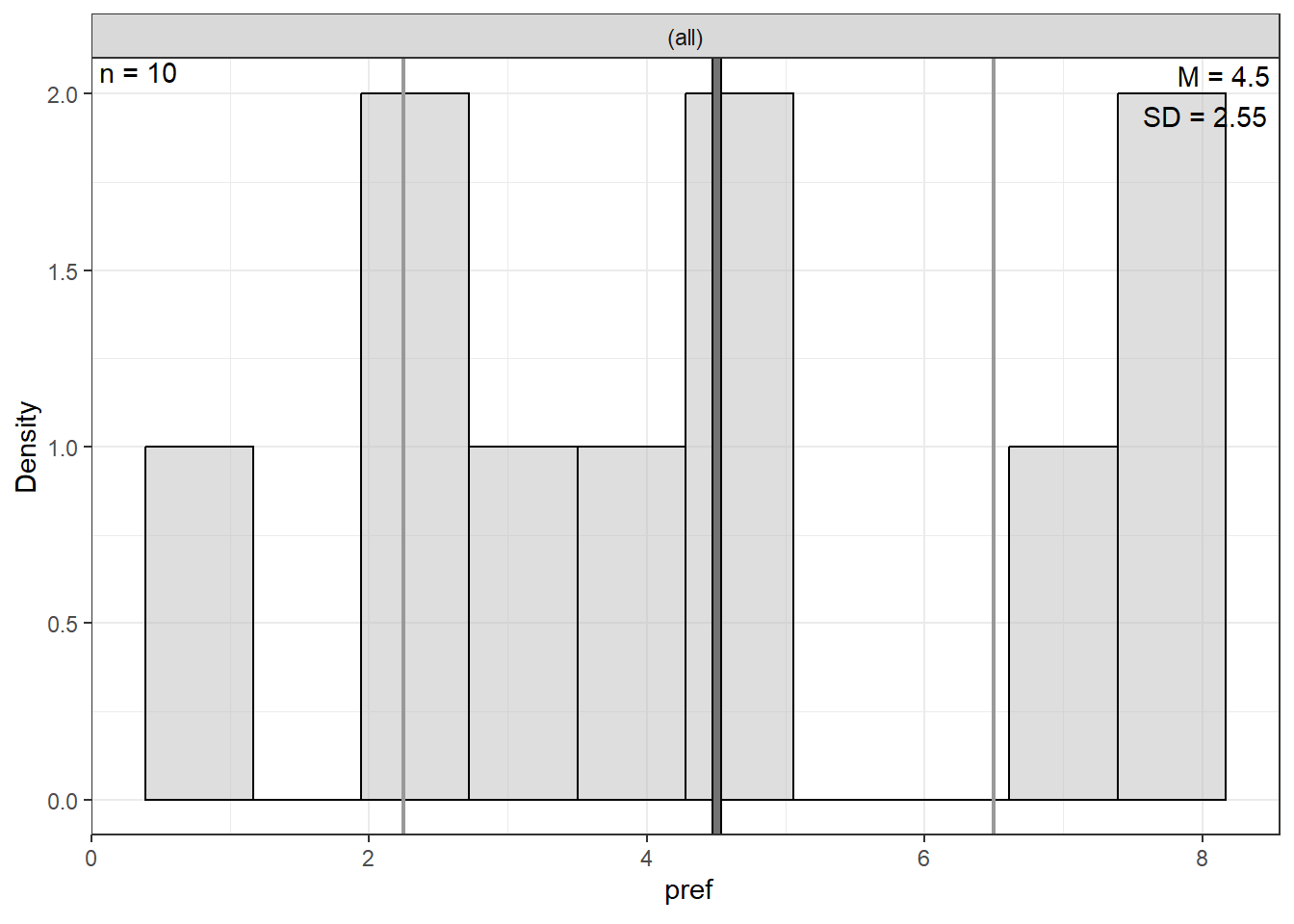
4.3.3 Semipartial Correlation
b | (SE) | p |
|
|
| |
|---|---|---|---|---|---|---|
(Intercept) | 3.90 | (0.20) | < .001*** | |||
soft | 0.20 | (0.01) | < .001*** | 2.45 | .949 | .987 |
basket | -0.20 | (0.01) | < .001*** | -2.44 | .943 | .987 |
R² | .987 | |||||
Adjusted R² | .983 | |||||
Note. N = 10. = standardize coefficient; = semi-partial correlation; = partial correlation; p = significance from Wald t-test for parameter estimate. | ||||||
* p < .05. ** p < .01. *** p < .001. | ||||||
b | (SE) | p |
|
|
| |
|---|---|---|---|---|---|---|
(Intercept) | 3.90 | (0.20) | < .001*** | |||
soft | 0.20 | (0.01) | < .001*** | 2.45 | .949 | .987 |
basket | -0.20 | (0.01) | < .001*** | -2.44 | .943 | .987 |
R² | .987 | |||||
Adjusted R² | .983 | |||||
Note. N = 10. = standardize coefficient; = semi-partial correlation; = partial correlation; p = significance from Wald t-test for parameter estimate. | ||||||
* p < .05. ** p < .01. *** p < .001. | ||||||
# A tibble: 2 × 5
Term r2_semipartial CI CI_low CI_high
<chr> <dbl> <dbl> <dbl> <dbl>
1 soft 0.949 0.95 0.756 1
2 basket 0.943 0.95 0.737 14.3.4 Venn Diagram - Variances
https://freetools.touchpoint.com/venn-diagram-template-generator
[1] 6.5[1] 6.216137[1] 6.254138[1] 0.08349447[1] 6.416506[1] 0.1623674[1] 0.2003681[1] 6.053774.3.5 Venn Diagram - Proportions
Total Variance in Preference Explained by Both Skills
[1] 0.9871547Variance in Preference Uniquely Explained by Softball skills, across all Basketball skill levels
[1] 0.0249796Variance in Preference Uniquely Explained by Basketball skills, across all Softball skill levels
[1] 0.03082587Variance in Preference Explained by Softball skills, when holding Basketball skill constant
[1] 0.6604009[1] 0.7058631